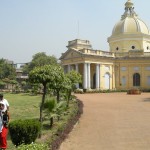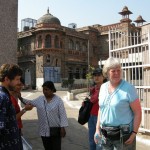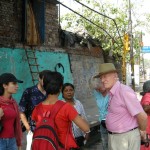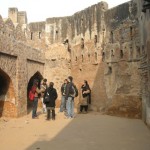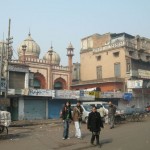Braving the summer heat, a group of heritage enthusiasts got together to explore the landmarks of the revolt of 1857 in Delhi. We covered sites located in the neighbourhood of Kashmiri Gate which falls within the old city, the former Mughal capital of Shahjahanabad. The starting point was Nicholson’s cemetery, named after Brigadier General John Nicholson who died fighting the rebels in 1857. He was fatally shot during the storming of Lahori gate, during recapture of Delhi by the British in September 1857. Another important person who is buried here is Master Ramachandra, professor of Mathematics in the then Delhi College. Across the road from Nicholson’s cemetery are remains of the city walls and the Kashmiri gate. The road roughly marks the demarcation between rebels inside the city and where the British were camped on the Ridge. The Kashmiri gate is one of the four surviving gates of the boundary of Shahjahanabad. The others which still stand are Ajmeri gate, Turkman gate & Dilli gate. Kashmiri gate still bears the damaged done to it by the British cannons while storming the city. There is also a memorial to the dead of the British army at this gate. Continue Reading This Post
Archive for the ‘1857’ Category
Heritage Walk to Kashmiri gate & neighbourhood, 25 April 2010
This heritage walk covers the modern neighbourhood of Kashmiri Gate near the ISBT. Most of the sites here relate to first half of 18th century and some specific events associated with the revolt of 1857. In the 17th century this area was part of the Mughal capital of Shahjahanabad, what is today old Delhi. Kashmiri gate has mansions of some important personalities associated with the Mughal court like, Ali Mardan Khan, the noble who was instrumental in building canals which brought water to the city and Dara Shukoh, Shahjahan’s son. Later, the British started living in this neighbourhood. It is their buildings which mostly survive now.
We started the heritage walk from Nicholson’s cemetery. John Nicholson was a British general, instrumental in breaching the defenses of rebels who were controlling Delhi, and in the process lost his life. The cemetery is named after him, but there are other important people buried here as well. Continue Reading This Post
Heritage trail: landmarks of 1857, 21 March 2010
- near Nicholson’s cemetery
- old city walls
- inside old city walls
- old St. Stephen’s college
- St. James’ Church
- Dara’s library
- David Ochterlony’s Residency
- Lothian road
Here are some of the pictures of heritage walk exploring Kashmiri gate and its neighbourhood. Most landmarks on this trail relate to the Uprising of 1857. We started from Nicholson’s cemetery. The cemetery is named after John Nicholson, the British commander who died in the fighting during siege of Delhi. Another prominent burial is that of Master Ramachandra of Delhi College fame. An Indian convert to Christianity, he was one of the foremost intellectuals of 19th century. The city walls of Shahjahanabad, the Mughal capital, start almost immediately across the road from the Nicholson’s cemetery. Not much of it remains but some parts are still traceable alongside the Kashmiri gate. Kashmiri gate is one of the remaining gates of the city. The others are: Turkman, Ajmeri and Dilli gates. The breaching of this gate was crucial in turning the tide in favour of the British. The gate still bears the damage done during the fighting. There are large chunks missing in its façade, from impact of canon balls. Continue Reading This Post
Heritage trail, landmarks of 1857
This heritage trail covers sites associated with late-Mughal period and landmarks of the uprising of 1857. We began at Nicholson’s cemetery and spent some time sauntering around, looking at the interesting gravestones. Some are indeed beautifully carved. Besides Brigadier Gen. Nicholson’s, the cemetery also has Master Ramachandra’s grave. He is one of the most well known scholars associated with the Delhi College which is presently the Zakir Hussain College in Delhi University. Kashmiri gate, one of the most important landmarks of 1857 in Delhi, is easily missed by people in its neighbourhood. The area also has some city walls, parts of which are still visible around the ISBT. We passed the Lal Masjid, old Hindu college and old Stephen’s college while walking through the Bara bazaar in Kashmiri gate. The mass was over at St. James’ Church but the caretakers quite willingly reopened the church for us. There are several plaques on the church building naming martyrs of 1857. The churchyard also has graves of William Fraser, James Skinner and Skinner’s family burial ground. Next stop was the Dara Shikoh’s library and British Residency in the Indraprastha University campus. Just outside the campus is the telegraph memorial and remains of British magazine. Next to the GPO is Lothian Road cemetery which was closed. The view through the iron gates of the cemetery presented a picture of utter neglect. It is the earliest British cemetery in Delhi, and is presently in a very bad shape.
(posted by Rajesh Ranjan & Kanika Singh, team members, Delhi Heritage Walks)






